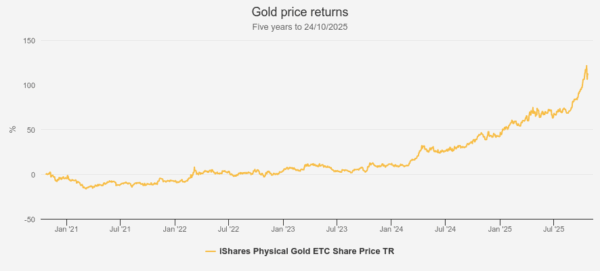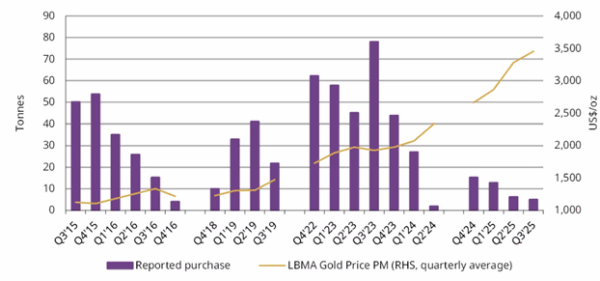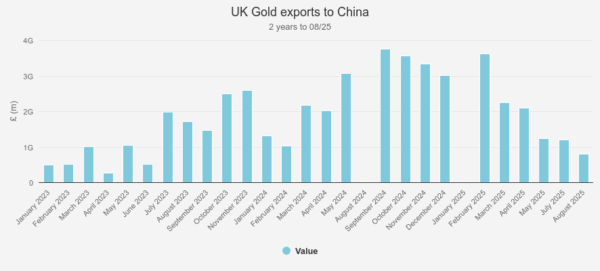Oct
2025
Is gold’s meteoric rise over?
DIY Investor
30 October 2025
Thomas McMahon gives his outlook for gold…
A dramatic fall in gold last week, with the metal down almost 6% in one day, raises the question whether it’s time to take profits. Even after the recent fall, gold is up over 50% year to date, rocketing from around $2,600 an ounce at the start of January to c. $4,100 at the time of writing. Can this move really be justified by the fundamentals?
Gold has been in a clear uptrend since late 2022. One of the main supports for this has been buying by central banks, in particular China. Sanctions on Russian assets raised fears that US dollar assets, like Treasuries held by other countries, might come under threat in future, a particularly acute concern for China given the poor trading relations with the US that continue to this day and the ongoing stand-off over Taiwan.

Source: Morningstar
Past performance is not a reliable indicator of future results
Gold’s move has accelerated over this period, with returns of 13.5% in 2023 and 27.2% in 2024, before the even more dramatic climb this year. Official gold purchases by the Chinese central bank have slowed over 2025, according to figures compiled by the World Gold Council, as the price has gone almost parabolic. This might suggest that China is wary of the recent run up, and is waiting to continue accumulating at better prices.

Source: World Gold Council
Past performance is not a reliable indicator of future results
We have to be cautious about placing too much weight on this data, as analysts suspect that the officially reported purchases and holdings are a fraction of the true numbers. One data point considered to reflect below-the-radar central bank buying is UK gold exports to China. This has also slowed into the teeth of the recent rally, and indeed shows a rather similar pattern to the official purchases in the chart above.

Source: HMRC
Meanwhile, shares outstanding in gold ETFs, which should reflect demand from Western investors, have soared. According to Bloomberg there has been 63% growth in the Goldman Sachs Physical Gold ETF Shares Outstanding Index this year, meaning a 63% rise in the number of shares outstanding, reflecting massive net inflows. In fact, the World Gold Council reports September’s inflows into ETFs were the highest ever. I suggest therefore that 2025’s rally in gold has been driven by Western investors and their concerns, and central bank buying has been less significant than it was last year.
There are a number of reasons Western investors might have been allocating heavily to gold, one of which is simply how well known the central bank buying argument has become. Investors may have been chasing momentum and looking to take advantage of this trend. This sort of source of demand is clearly going to be very sensitive to a sell-off and liable to reverse quickly.
Another reason is widespread concern about the fiscal health of key developed world economies. The UK’s problems will be well known by readers, while France is also struggling under high debt levels, low growth and political inability to reduce deficits. And the US, while it can boast a much better growth outlook, is also running huge deficits as a percentage of GDP and adding to a debt pile that is being shunned by one of its key investors, China, in favour of gold.
We can only speculate about the relative importance of these factors. However, I would argue that the sharp sell-off last week is itself one indication that pure momentum-seeking, trend-chasing speculation has played a role in 2025’s dramatic run up. If this is so, then it seems unlikely a rally of such violence will get going again after such a sharp correction. But this doesn’t necessarily mean that gold is vulnerable at its current price range.
While structural factors might be taking a back seat, they continue to be supportive. Tensions between the US and China remain high, and while the current dispute over tariffs may be resolved, which could lead to some downward pressure on gold in the short term, I think the strategic confrontation will remain, whoever is in the White House. Meanwhile, the loss of confidence in dollar assets post-Ukraine sanctions isn’t something that will reverse. And shifting reserves from dollars into gold is an offensive move as much as a defensive move, presenting a challenge to the US’s continued appetite for borrowing, and has to be appealing to China for this reason. As such, I would expect Chinese central bank buying to continue, with other emerging market central banks following suit.
Additionally, the fiscal pressures referred to above aren’t going to be relieved anytime soon. Both British and French analysts have raised the possibility of IMF bailouts due to the countries’ dreadful outlook. Meanwhile, the US could be more vulnerable than it first seems. It has been AI spend that has kept its economy motoring and its stock market rising, and should this tail off then US growth would fall and attention could quickly turn to its absurd deficit of 6% of GDP. Gold would be an obvious hedge for private or professional investors against currency debasement as a way out of debt traps, and the chaos that could be seen if a major Western country looks like it might default.
Conclusion: why do you own gold?
A lot of professional investors like to own gold as a hedge against tail risks. The concept of a hedge implies the asset won’t usually perform very well, but will provide returns or safety when equities and/or bonds fall. Recently, however, gold has been caught up in what looks like a speculative frenzy, potentially attracting the same investors who have been chasing performance in Nvidia or other tech names. I’m not getting sniffy here, the name of the game is making money. However, if this is right, then it might be due a pause and consolidation, and if enough ETF flows are from short-term performance chasers, we could see further falls.
But there are two reasons I think it still pays to have exposure to gold. The first is its quality as a hedge. In times of geopolitical risk and when the viability of government finances are being called into question, I think it makes sense to have exposure to gold. Investors are likely to turn to it in a crisis, even more so when debt sustainability is one of the potential sources of that crisis and when US Treasuries are considered less palatable than they once were by many investors round the world.
The second reason is that precisely these geopolitical dynamics mean a secular bull market may continue for many years to come, with ups and downs on the way. If we are seeing a decoupling of the US’s rivals from the dollar system, there is a lot of gold or alternatives that needs to be accumulated to whittle away at the relative size of US dollar assets on overseas balance sheets. This would be a multi-year trend, and while central banks may be less price-sensitive than some buyers, they can also easily step aside when the market gets frothy only to step back in when prices fall, which may be what we have seen over 2025.
A physically backed ETF therefore still looks like an attractive asset to own in a diversified portfolio, in my view. Additionally, investors might like to consider owning the miners, instead of or alongside the metal. Gold miners have outperformed gold this year, finally catching up from depressed valuations. However, Keith Watson, manager of Golden Prospect Precious Metals (GPM) points out that the ETFs have actually seen outflows over the year, in sharp contrast to the physical gold ETFs. Miners continue to attract very little attention despite their exceptional performance and the fact valuations remain reasonable, if not cheap. Keith estimates the industry is trading at around 1× the net present value of its assets, assuming a constant gold price out into the future, which is low by historic standards. Miners could be a cheaper way to keep exposure to gold, although given the equity beta and other factors influencing performance, they will likely have a different performance profile and may not be as pure a hedge. Gold and gold equities remain attractive, in my view, even if they may not see the same strong performance of the first nine months of 2025 in the next nine months.


Disclaimer
This is not substantive investment research or a research recommendation, as it does not constitute substantive research or analysis. This material should be considered as general market commentary.
Leave a Reply
You must be logged in to post a comment.